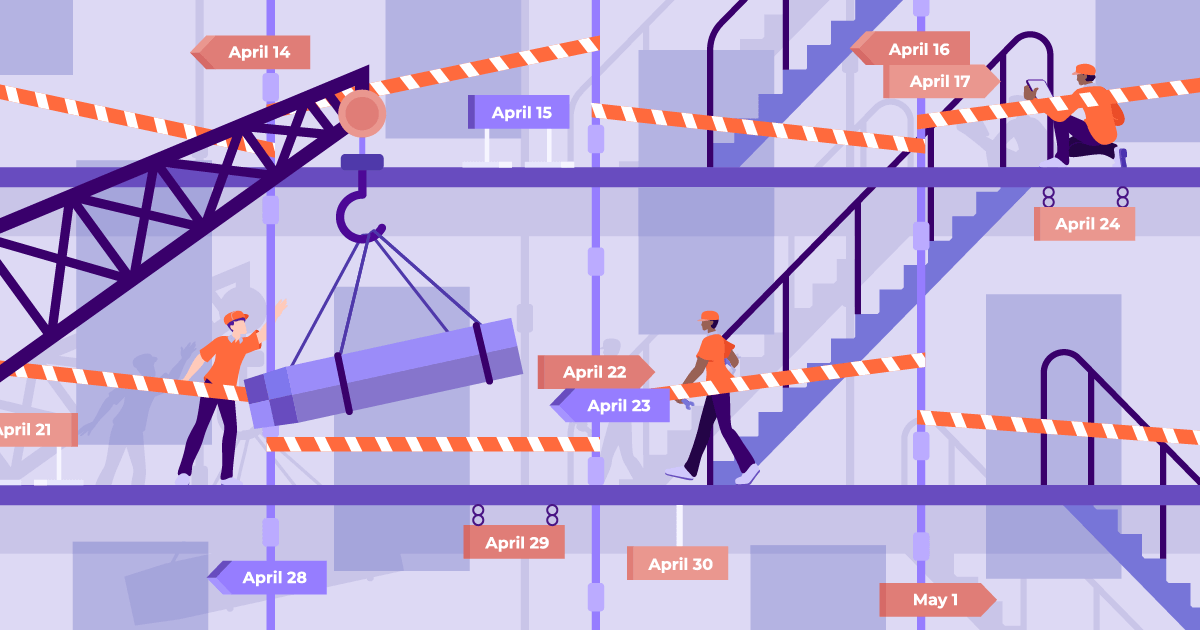Comprehensive Guide to Backhoe Loader Preventive Maintenance

Do you have an operation and maintenance manual? Have you scheduled essential weekly preventive maintenance? Do you have everything you need for job site safety and general maintenance?
Whether you’re in construction, landscaping, or any industry that heavily relies on these versatile machines, staying on top of maintenance can make all the difference in maximising their lifespan and performance on the construction site.
In this blog post, we’ll walk you through the significance of preventive maintenance for heavy equipment backhoe loaders and how it can save you from costly breakdowns and downtime. We’ll explore the key cutting edge components to focus on, share some expert tips for establishing a solid maintenance routine, and even highlight the benefits you can expect to see by implementing these practices. And lastly, find out how construction management software can help you.
So, if you’re eager to learn how to keep your backhoe loaders in top-notch condition, prevent unexpected hiccups, and ultimately boost your productivity, buckle up and get ready to delve into the wonderful world of preventive maintenance!

Understanding the Main Components of a Backhoe Loader
In the field service industry, when it comes to backhoe loaders, regular maintenance is crucial to keep them running smoothly and efficiently. To help you stay on top of things, let’s dive into the key components that require your attention:
- Engine: The heart of the backhoe loader, the engine provides the power needed to operate the machine. Regular maintenance of the engine is essential to ensure optimal performance. This includes oil and filter changes, checking and replacing belts, inspecting the cooling system, and keeping an eye on fuel quality. A well-maintained engine ensures reliable operation and efficient fuel consumption.
- Hydraulic System: The hydraulic system enables the backhoe loader to perform its essential functions, such as raising and lowering the bucket, extending and retracting the boom, and operating various attachments. Regular maintenance involves checking hydraulic fluid levels, inspecting hoses and connectors for leaks or damage, and replacing filters. Proper maintenance of the hydraulic system ensures smooth and precise movements, preventing costly breakdowns.
- Bucket and Boom: These components are responsible for the backhoe loader’s digging and lifting capabilities. Regular maintenance includes inspecting the bucket teeth for wear and tear, ensuring smooth movement of the boom and stick, and lubricating the joints. By keeping the bucket and boom in excellent condition, you’ll optimise their digging performance and extend their lifespan.
- Operator’s cabin: The operator’s cabin is where the magic happens, as it houses the controls and provides a comfortable working environment. Regular maintenance involves inspecting the cabin for any damage or wear, checking the seat and safety belts, cleaning air filters, and ensuring proper ventilation. A well-maintained cabin promotes operator safety, comfort, and overall productivity.
Understanding the function of these components is crucial to appreciate their role in the backhoe loader’s overall operation:
The engine powers the machine and provides the necessary force to perform various tasks. It converts fuel into mechanical energy, allowing the backhoe loader to move, lift, and dig.
The hydraulic system, with its fluid-filled lines and cylinders, enables precise control of the backhoe loader’s movements. It translates operator commands into powerful actions, making it essential for accomplishing tasks efficiently and safely.
The bucket and boom are the workhorses of the backhoe loader. The bucket, with its digging teeth, scoops up materials and transfers them. The boom and stick provide reach and height, allowing the backhoe loader to operate in tight spaces or lift heavy loads.
The operator’s cabin serves as the control centre where operators steer the machine and operate its functions. A well-designed and maintained cabin ensures operator comfort, safety, and productivity, allowing them to work efficiently for extended periods.
To find out more about machines running at peak power, or information on backhoe operators, you can always consult your backhoe owner’s manual or contact your manufacturer. Ensure to always read the warning labels before you perform your basic daily maintenance.
Daily Maintenance Checks for Backhoe Loaders
By investing just a few minutes each day to inspect and address potential issues, you can save yourself from costly repairs and unexpected downtime. No one wants to find out your hydraulic systems have failed right before an important job starts.
Here’s a detailed list of daily checks to perform on your backhoe loader:
- Fluid Levels:
- Check engine oil level and ensure it’s within the recommended range.
- Inspect hydraulic fluid level and top up if necessary.
- Verify coolant level to prevent overheating.
- Check fuel level and refill as needed.
- Leaks and Hoses:
- Inspect the machine for any signs of leaks, such as oil, hydraulic fluid, or coolant.
- Check hydraulic hoses and connections for damage, leaks, or loose fittings.
- Ensure all hose clamps are secure and in good condition.
- Tires and Rims:
- Check tire pressure and ensure it meets the manufacturer’s recommendations.
- Inspect tires for any signs of damage, such as cuts, bulges, or excessive wear.
- Verify that rims are in good condition without any cracks or deformities.
- Lights and Signals:
- Test all lights, including headlights, taillights, brake lights, and turn signals.
- Check the functionality of warning indicators and alarms.
- Ensure all safety reflectors are clean and visible.
- Filters and Air Intake:
- Inspect and clean or replace the engine air filter if necessary.
- Check the hydraulic system’s filters and clean or replace them as recommended.
- Clean the air intake vents to prevent dust and debris from entering the engine.
- Battery:
- Check the battery terminals for corrosion and clean if needed.
- Inspect the battery’s charge level and ensure it’s within the recommended range.
- Belts and Pulleys:
- Inspect engine belts for wear, cracks, or signs of damage.
- Verify proper tension of belts and adjust if necessary.
- Check pulleys for any misalignment or damage.
- Safety Equipment:
- Ensure all safety features, such as seat belts, roll bars, and ROPS (Rollover Protective Structure), are in good condition.
- Test the functionality of emergency stops and switches.
- Lubrication:
- Check and lubricate key components, including joints, pivot points, and moving parts as recommended by the manufacturer.
- Operator’s Cabin:
- Inspect the operator’s cabin for any damage or wear.
- Clean and ensure all controls, gauges, and displays are functioning properly.
Ensure to always consult the manufacturer recommended maintenance procedures before you begin basic preventive maintenance.
Periodic Maintenance for Backhoe Loaders
Periodic maintenance tasks are essential for the efficient operation of backhoe loaders. These tasks include replacing filters (engine oil, fuel, hydraulic system, and air filters) to maintain clean fluids and prevent contaminants from damaging the engine or hydraulic system. Lubricating moving parts, such as loader arms, joints and pivot points, reduces friction and wear.
Regular preventative maintenance inspections and adjustments of belts, chains, and bolts ensure proper tension and secure connections. Fluid analysis, electrical component inspections, and hydraulic hose checks help identify potential issues early on.
Component replacements, as needed, ensure optimal performance. Following suggested frequencies for these tasks minimises breakdowns, extends component life, optimises fuel consumption, reduces downtime, and enhances operator safety.
By performing periodic maintenance, backhoe loaders will consistently deliver reliable performance and productivity, maximising return on investment.
Cleaning and Proper Storage of Backhoe Loaders
Cleaning and proper storage are essential for backhoe loader maintenance. Regular cleaning helps remove dirt, debris, and moisture, preventing corrosion and enhancing performance. Here are some useful tips:
- Wash the machine with mild detergent and water, paying attention to hard-to-reach areas.
- Clean the engine compartment and hydraulic system, addressing any leaks or issues.
- Thoroughly clean the undercarriage to prevent build-up and protect against corrosion.
- Apply grease to lubrication points after cleaning to maintain smooth movement.
- Store the backhoe loader in a dry, covered area away from extreme temperatures.
- Consider disconnecting the battery or using a battery maintainer for long-term storage.
- Conduct regular inspections during storage for any damage, leaks, or pest infestations.
By following these practices, you can preserve the backhoe loader’s condition, prevent rusting and damage, and ensure it’s ready for optimal performance when needed.
The Importance of Maintenance Records in Backhoe Loader Upkeep
Keeping comprehensive maintenance records for backhoe loaders is crucial for various reasons. These records provide a detailed history of maintenance activities, including inspections, repairs, and part replacements, helping track the machine’s maintenance timeline and condition. They serve as proof of regular maintenance for warranty claims and compliance purposes.
Maintenance records aid in troubleshooting and diagnosing issues by providing a reference to past repairs and tasks performed. They enhance the resale value of the equipment by demonstrating responsible ownership. These records also assist in planning and scheduling future maintenance, optimising performance and minimising downtime.
During audits and inspections, maintenance records serve as evidence of proper maintenance practices and compliance with regulations. To maintain comprehensive records, document all maintenance activities, keep them organised and accessible, and update them regularly.
By maintaining detailed maintenance records, you ensure transparency, enhance equipment value, and enable effective maintenance management.
Troubleshooting Common Backhoe Loader Maintenance Issues
Backhoe loaders can encounter various common maintenance issues, including hydraulic system problems, electrical system failures, engine performance issues, transmission troubles, braking system malfunctions, steering and suspension problems, and cooling system failures. To diagnose and resolve these problems:
- Check for visible leaks, inspect connections, and ensure proper fluid levels for hydraulic system issues. Seek professional help if the problem persists.
- Inspect fuses, connectors, and wiring for electrical system failures. Consult an electrician or technician if you’re unable to identify or fix the issue.
- Check air filters, fuel and oil levels, and spark plugs for engine performance issues. Consult a mechanic or authorised service centre for complex repairs.
- Inspect transmission fluid levels, condition, and check for leaks for transmission troubles. Seek professional assistance for accurate diagnosis and repairs.
- Inspect brake components and hydraulic lines for braking system malfunctions. Professional help is recommended for brake system repairs.
- Inspect steering and suspension components for issues. Consult a professional technician for proper diagnosis and repairs.
- Inspect for coolant leaks, check coolant levels and quality, and clean the radiator for cooling system failures. Seek professional assistance for complex repairs.
When unsure, it’s best to consult a qualified professional or authorised service centre for accurate diagnosis and resolution of maintenance issues. Their expertise ensures the safety and optimal performance of your backhoe loader.
Implementing a Preventive Maintenance Program for Backhoe Loaders
Implementing a preventive maintenance program for backhoe loaders offers numerous benefits, including enhanced equipment reliability, increased lifespan, cost savings, improved safety, and increased productivity.
Key features of a successful program include establishing a maintenance schedule, maintaining comprehensive documentation, providing training and education, utilising an inspection checklist, and regularly reviewing and improving the program.
To set up a preventive maintenance program, establish a maintenance schedule based on manufacturer guidelines, create a documentation system, train personnel, develop an inspection checklist, and continuously review and improve the program.
By implementing a preventive maintenance program, you can optimise the performance and longevity of your backhoe loaders while minimising downtime and costly repairs.
Safety Measures in Backhoe Loader Maintenance
Safety is of utmost importance during backhoe loader maintenance activities. A safety-conscious culture plays a crucial role in ensuring better maintenance outcomes and reducing accidents.
By prioritising safety, maintenance personnel are more likely to follow proper procedures, use appropriate protective equipment, and adhere to safety guidelines. This reduces the risk of injuries, damage to equipment, and work-related accidents.
A safety-conscious culture promotes regular training and awareness, encouraging personnel to identify potential hazards, report concerns, and actively participate in creating a safe work environment. When safety is a top priority, maintenance activities are conducted with caution and attention to detail, resulting in more effective maintenance outcomes, reduced equipment downtime, and improved overall workplace safety.
Leveraging FieldInsight for Backhoe Loader Maintenance
FieldInsight offers a range of features that can streamline backhoe loader maintenance, providing numerous benefits for businesses. With FieldInsight, businesses can efficiently manage and track maintenance tasks, resulting in improved productivity and streamlined operations.
The software enables businesses to schedule and assign maintenance tasks to the appropriate personnel, ensuring timely completion. It also provides a centralised platform for recording and accessing maintenance records, making it easier to track maintenance history, identify trends, and plan future maintenance activities.
FieldInsight’s intuitive interface and mobile accessibility allow technicians to access maintenance tasks, record progress, and report issues in real-time, eliminating the need for paperwork and enhancing communication.
By using FieldInsight, businesses can optimise their maintenance processes, increase efficiency, minimise equipment downtime, and ultimately boost productivity and customer satisfaction.
Takeaways for backhoe maintenance
By implementing a comprehensive preventive maintenance program, businesses can reap numerous benefits. Regular maintenance checks, daily inspections, and periodic tasks such as lubrication, filter replacements, and bolt tightening are crucial for keeping backhoe loaders in top shape. Additionally, cleaning and proper storage play a vital role in preventing rust, damage, and other potential issues.
FieldInsight, a powerful field service software, streamlines backhoe loader maintenance by providing features for task management, record-keeping, and real-time communication. It enables businesses to schedule and assign maintenance tasks efficiently, track maintenance records, and enhance collaboration among technicians.
By leveraging FieldInsight, businesses can streamline their maintenance processes, optimise efficiency, and ultimately save time and boost productivity. Remember, a proactive approach to maintenance, supported by comprehensive records and a safety-conscious culture, ensures reliable equipment, reduces accidents, and leads to long-term success in the field.
Check out FieldInsight for a comprehensive solution to backhoe loader maintenance today.
What You Should Do Now
- Book a Demo. You’ll be in touch with an automation expert who has worked in this space for over 5 years, and knows the optimal workflow to address your needs.
- If you’d like access to free articles about managing HVAC workflows, go to our blog.
- If you know someone who’d enjoy reading this page, share it with them via email, Linkedin, Twitter, or Facebook.







